Portrait miniatures are a fascinating part of art history, admired by many for their fine detail and skill in a diminutive style. Unlike some traditional forms of art, miniatures can be found with the use of many different materials in their production, from watercolours, gouache, graphite and enamels to copper plates, vellum, playing cards and ivory. You may find portrait miniatures in their own frames, within lockets and jewellery, or upon decorative items such as snuff boxes.
 Above: a selection of miniatures including a self portrait by John Singleton Copley (1769), a portrait of Mabel Morrison by Charles Lepec (1866) and a portrait of a woman by Frédéric Dubois (1794)
Above: a selection of miniatures including a self portrait by John Singleton Copley (1769), a portrait of Mabel Morrison by Charles Lepec (1866) and a portrait of a woman by Frédéric Dubois (1794)
Miniatures are often viewed through a magnifying lens, this means that the slightest flaw in their composition or surface may show up more readily than a larger artwork. In contrast to a small visual disturbance on a regular scale watercolour, the same issue may completely distract the overall appearance of a miniature. Therefore, it is important to always contact a professional conservator who will understand the importance of this, and who knows the limitations to which a restoration should be conducted to avoid any overbearing changes on the small piece when viewed under a magnifying glass.
With so many materials found in this area of artwork, it is important to understand their context and how best to protect them. Our trained conservators are able to provide miniature restoration treatment that sensitively repairs any visual disturbance, as well as offering protection from any elements which may cause deterioration. In this article we will cover the history of portrait miniatures, the different types of materials you may come across, and how best to protect them.
 Above: a selection of early 19th century miniatures including a self portrait by an unknown artist (1800–1805), a stuff box lid with portraits of two sisters (1800) and a portrait of a man by Jeremiah Paul (1800)
Above: a selection of early 19th century miniatures including a self portrait by an unknown artist (1800–1805), a stuff box lid with portraits of two sisters (1800) and a portrait of a man by Jeremiah Paul (1800)
The history and value of portrait miniatures
Before the dawn of photography, portrait miniatures were a common way to keep pictures of loved ones nearby. Dating from the renaissance period onwards, this delicate art form reached a height in fashion during the 18th century, when they became more readily available to the developing middle classes and no longer exclusive to aristocracy alone. Such artworks were often commissioned before a family member passed away or was to be absent for a long period of time, such as a soldier leaving for war or a daughter who was about to be married. They also served a purpose during courtship, as a devotion to political figures, and as diplomatic gifts.
 Above: a selection of portrait miniatures in decorative frames including work by Anne Mee, Gervase Spencer, Henry Edridge, Ozias Humphry, Thomas Day, school of Andrew Plimer and Samuel Collins
Above: a selection of portrait miniatures in decorative frames including work by Anne Mee, Gervase Spencer, Henry Edridge, Ozias Humphry, Thomas Day, school of Andrew Plimer and Samuel Collins
Traditionally, portrait miniatures may have been passed down as a family heirloom, but they have always been highly collectible. In 1733, it was recorded that a gentleman’s huge collection of miniatures were lost in a London fire, this collection had included works from centuries prior. Today, a large market exists for miniatures, with popularity at auction that can see specialist pieces sell for hundreds of thousands of pounds. Their appeal can also see pieces estimated at just £250 sell for £2,500 as collectors bid with enthusiasm.
 Above: a selection of 18th century miniatures by Richard Cosway
Above: a selection of 18th century miniatures by Richard Cosway
Famous names in the world of portrait miniatures include Richard Cosway, a renowned English artist whose most popular works date to the end of the 18th century and early 19th century. Cosway signed his name on the back of the portrait, with very few exceptions with the signature on the front. Richard Cosway’s work has sold for up to £80,000. Similar in style to Cosway, George Engleheart is another famous name from this era. His works are often signed simply with an ‘E’ or ‘G.E’. and often valued in the upwards of thousands.
 Above: a selection of regency miniatures by George Engleheart
Above: a selection of regency miniatures by George Engleheart
John Smart is also notable for having produced portraits during his stay in India, including members and their families of the East India Company, as well as Indian royalty. Young men in the East India Company would have their portraits made as soon as they arrived, to be sent to their families as proof of their health and to be used to secure a wife on their return home. Various portraits by John Smart have sold for £50,000 – £60,000 in recent years.
 Above: a selection of 18th century miniatures by John Smart
Above: a selection of 18th century miniatures by John Smart
More historically, Nicholas Hilliard is a renaissance artist who was patronised by Queen Elizabeth I. Originally a goldsmith, his work can be combined with jewellery such as fine brooches which may have been worn by the monarch herself. In 2007 one of his portraits sold for £120,500. A student of Hilliard named Isaac Oliver also fetches high results at auction, including a 2013 sale of £362,500 for an 8 x 5 inch portrait in a tortoiseshell frame.
 Above: a selection of 16th century miniatures by Nicholas Hilliard
Above: a selection of 16th century miniatures by Nicholas Hilliard
Some miniatures may have interesting stories behind them. Portraits of reigning kings and queens were popular as keepsakes for their most devoted subjects. A series of miniature portraits of the same woman dating from the mid 17th century was discovered to bear a striking resemblance to the executed King Charles I. They were in fact a prime example of a costume overlay that was used to hide the true identity of the sitter so that the owner could keep their likeness nearby without any personal or dangerous political issues arising. Sometimes this overlay could be removed and replaced, as it was made out of a thin layer of mica. This unusual addition could enhance the value of a miniature, but it must be professionally protected in order to retain the historic intrigue and integrity.
 Above: a selection of 17th century miniatures by John Hoskins, Samuel Cooper and Peter Oliver
Above: a selection of 17th century miniatures by John Hoskins, Samuel Cooper and Peter Oliver
Miniature facts and figures
- Miniatures were developed from the skills used in illuminated manuscripts
- Charles I commissioned miniatures of various Old Master artworks in his collection.
- In 2007 a miniature of Oliver Cromwell by Samuel Cooper sold for £460,000 at auction.
- Eye miniatures were a Georgian trend to commission a painting of the eye of a family member, child, friend or loved one.
- A portrait of Queen Elizabeth I by Nicholas Hilliard sold for £230,000 at auction in 2007.
Protecting miniatures on paper and parchment and ivory
Portrait miniatures on paper, parchment (vellum) or ivory are often created with the use of watercolours or pigments which are susceptible to fading when exposed to UV rays from sunlight. As such, it is important to keep miniatures in a shaded location with no more than 50 LUX.
These mediums may also face dangers from their environment depending on the temperature and humidity of the atmosphere. Artist Nicholas Hilliard himself noted of his works that ‘the colours may not endure some airs, especially sulphurous air or sea-coal…’ which highlights the sensitivity of these artworks and the atmospheric challenges they may have faced in the centuries since their creation. Deterioration can be compelled by both historic and recent atmospheric conditions.
 Above: a miniature portrait on paper that was accidentally rubbed away, before and after restoration using historic photographs of the sitter
Above: a miniature portrait on paper that was accidentally rubbed away, before and after restoration using historic photographs of the sitter
Like works on paper, a humid atmosphere will incur mould growth or foxing, as well as the risk that condensation forms inside the frame and dampens the artwork. A very dry atmosphere may produce brittle paper or parchment, as well as causing an ivory base to split and crack. To avoid this damage it is recommended that the humidity is kept no higher than 55% and the temperature at around 15 degrees celsius.
Our conservators specialise in different areas which cover works on these mediums. Our paper conservator can treat paper and parchment with gentle solutions to clean away any discolouration or mould growth, as well as re-stabilising any brittle areas. Our ceramics conservator is able to address ivory, including treatments to address stability and if appropriate the use of a synthetic substance to replace missing areas. Our team also provides framing options for further protection if required. You can read more about ivory restoration here.
Protecting miniatures on copper
When a painting is on a metallic surface it may be at higher risks of scratches and abrasions disturbing the paint layer visually and structurally. It is also vulnerable to many of the issues facing metal, such as bends, corrosion and rusting. Keeping a painting on copper in a dry environment with a secure and protective frame will help in preventing this type of accidental damage from occurring.
 Above: a miniature on copper before and after conservation treatments in our studio
Above: a miniature on copper before and after conservation treatments in our studio
One of the biggest threats to any artwork on copper is exposure to water or high levels of moisture, this may lead to oxidation which can begin a process of decay and weakening. If a miniature on copper is exposed to water, contact our team as soon as possible for preventative treatments. Our conservators avoid water-based solutions when cleaning such artworks to ensure that there is no threat of rust, instead, they use a custom-made gel treatment.
Copper can be bent out of shape through accidental knocks or falls, once they have been disturbed in this way it is difficult to reverse the damage. The bend in the surface may cause the paint layer to become disturbed with cracking and flaking. To prevent further losses our conservators can carefully stabilise the paint, again with solvents that are free of water to avoid oxidation. This can also be used on areas with abrasions or broken paint to prevent continued deterioration.
A family set of miniatures on copper recently came to our studio, they were restored by our team with techniques that reduced visual disturbances and ensured future preservation. The miniatures were stabilised and carefully retouched with specialist pigments, expertly colour-matched. These 17th-century pieces had a sentimental quality, as they are a rare example of a full family set that has survived intact. The finished pieces were returned to their original tones, allowing the full details of the artwork to be revived.
Read more about miniature restoration and preservation, or please contact our team today via [email protected] and we will be happy to help.

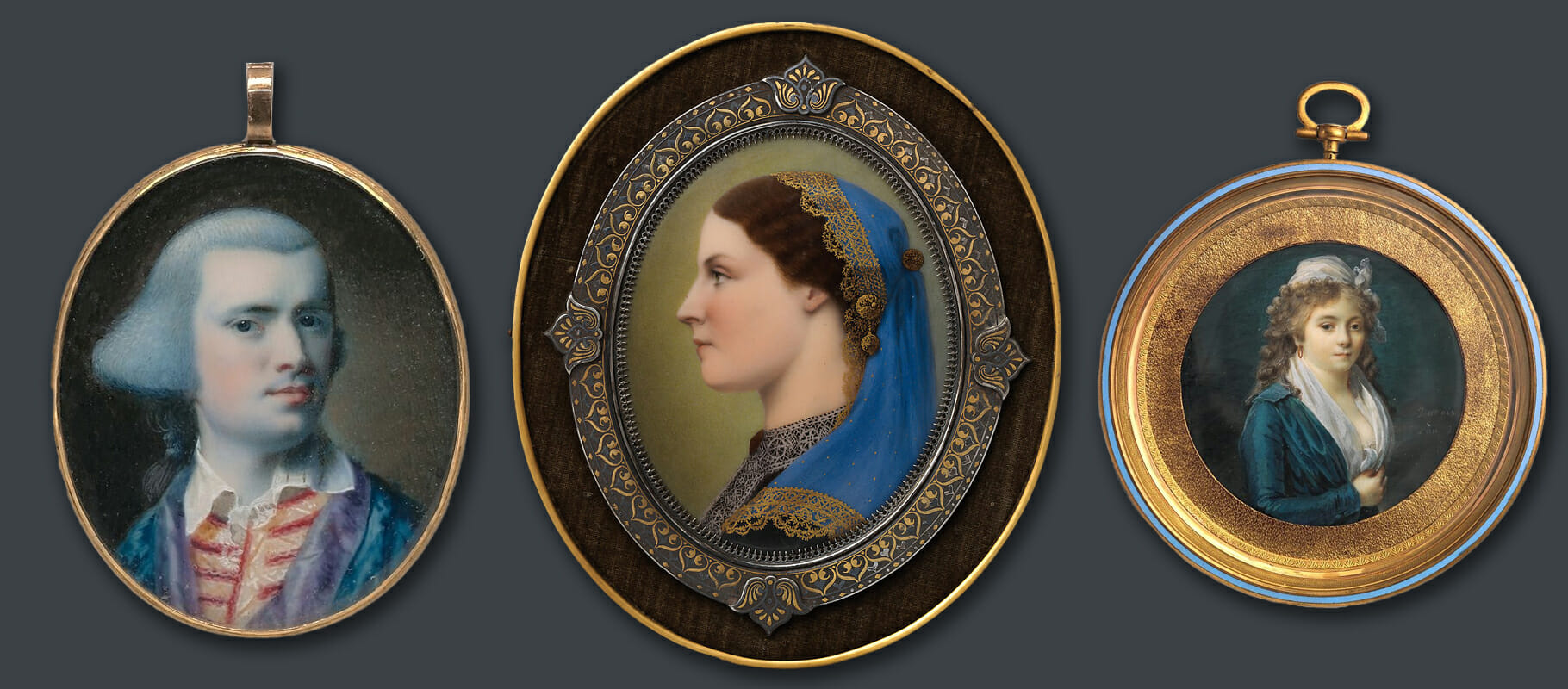 Above: a selection of miniatures including a self portrait by John Singleton Copley (1769), a portrait of Mabel Morrison by Charles Lepec (1866) and a portrait of a woman by Frédéric Dubois (1794)
Above: a selection of miniatures including a self portrait by John Singleton Copley (1769), a portrait of Mabel Morrison by Charles Lepec (1866) and a portrait of a woman by Frédéric Dubois (1794)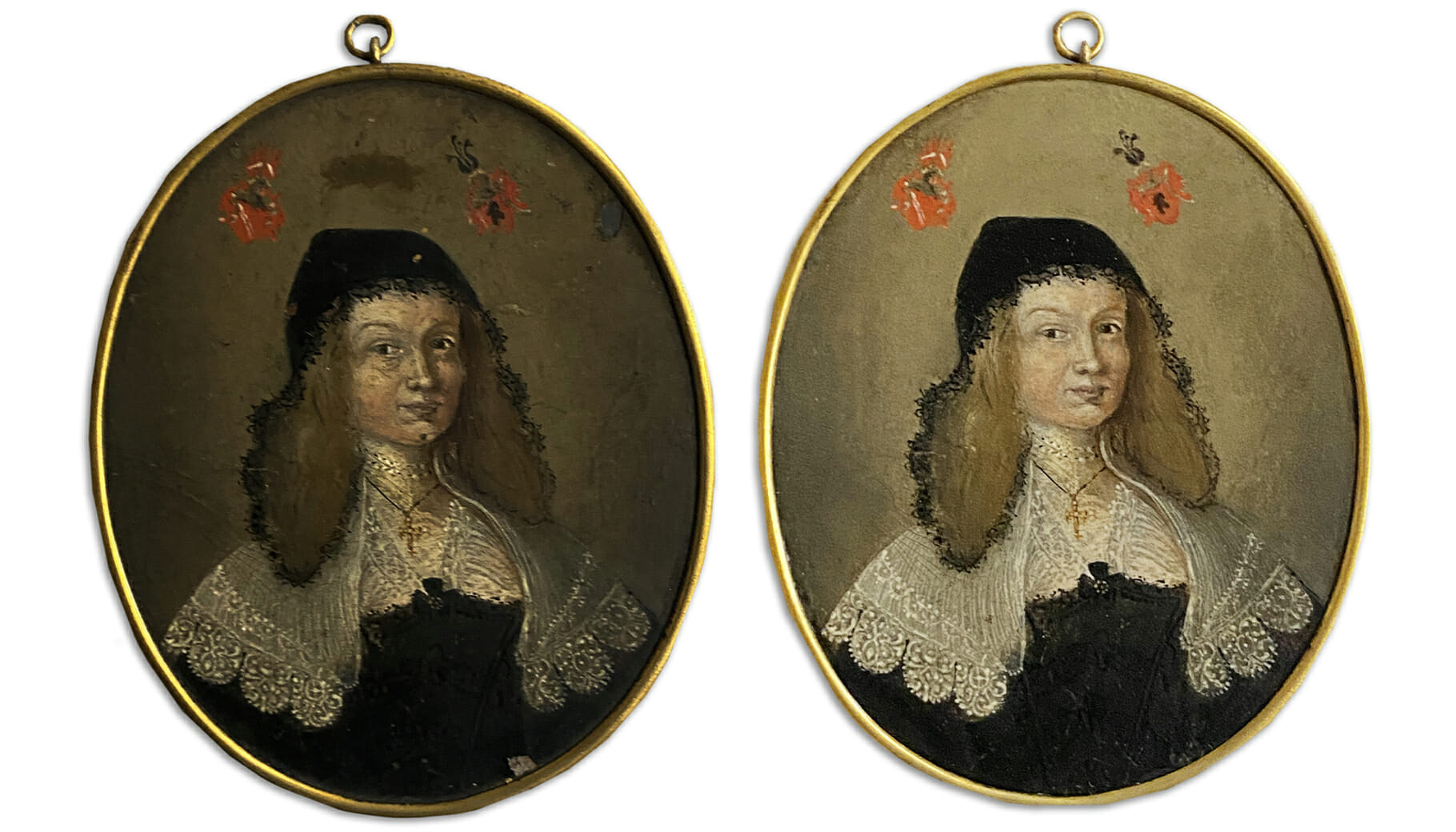
 Above: a selection of early 19th century miniatures including a self portrait by an unknown artist (1800–1805), a stuff box lid with portraits of two sisters (1800) and a portrait of a man by Jeremiah Paul (1800)
Above: a selection of early 19th century miniatures including a self portrait by an unknown artist (1800–1805), a stuff box lid with portraits of two sisters (1800) and a portrait of a man by Jeremiah Paul (1800)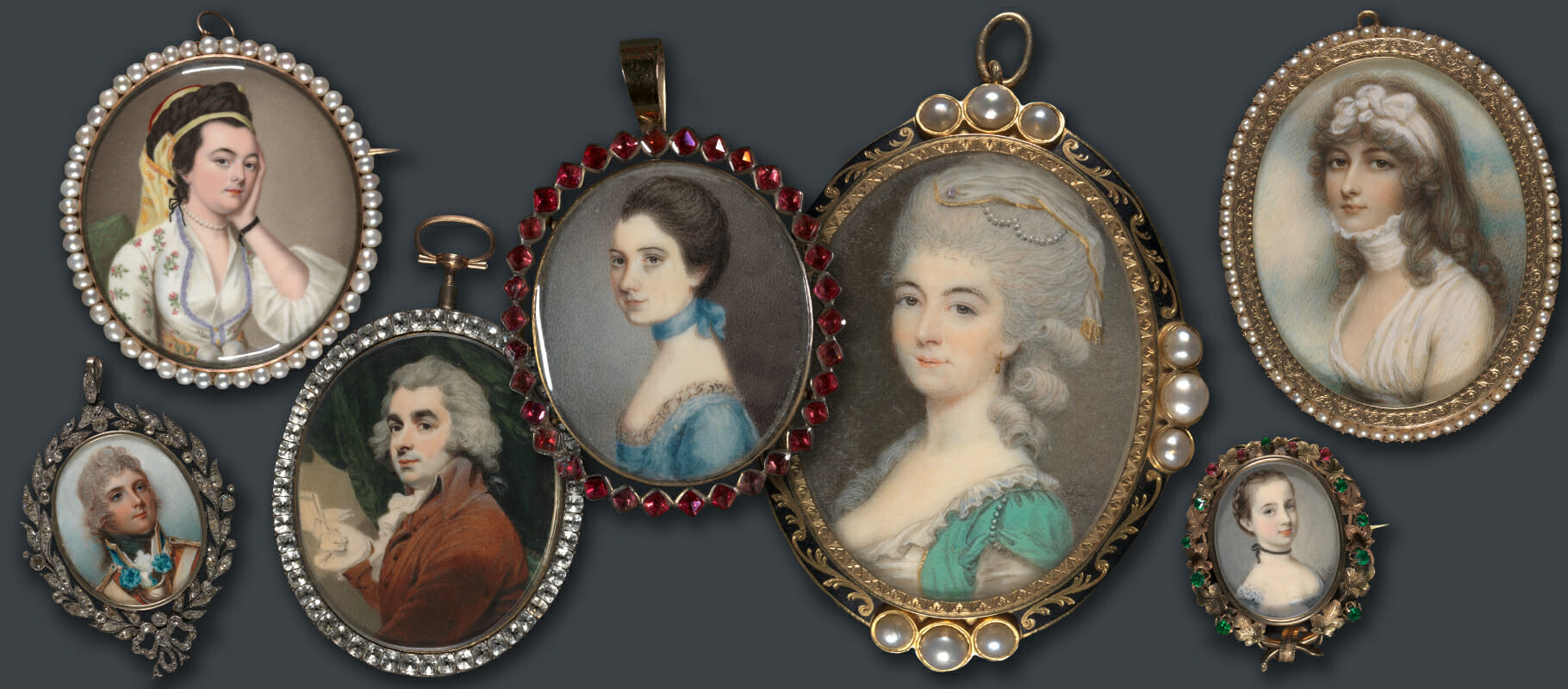 Above: a selection of portrait miniatures in decorative frames including work by Anne Mee, Gervase Spencer, Henry Edridge, Ozias Humphry, Thomas Day, school of Andrew Plimer and Samuel Collins
Above: a selection of portrait miniatures in decorative frames including work by Anne Mee, Gervase Spencer, Henry Edridge, Ozias Humphry, Thomas Day, school of Andrew Plimer and Samuel Collins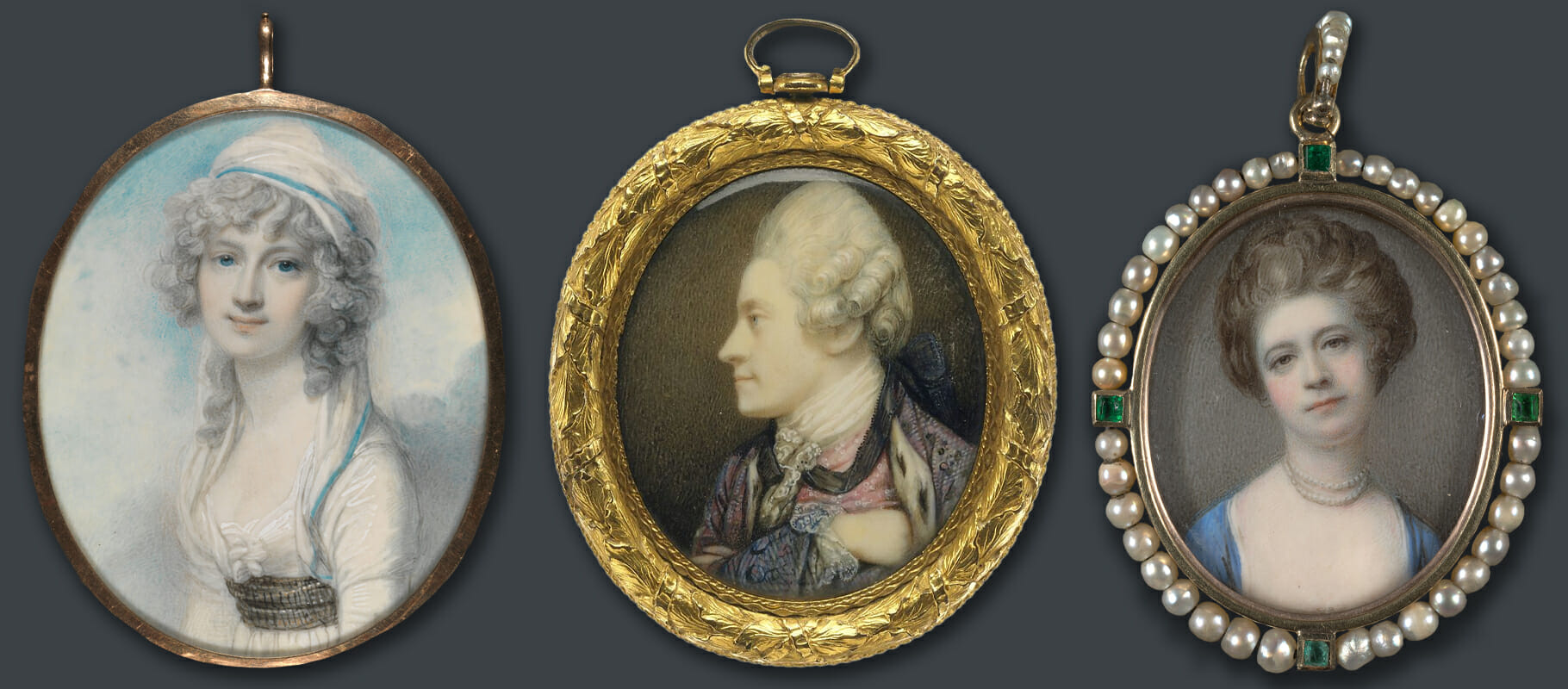 Above: a selection of 18th century miniatures by Richard Cosway
Above: a selection of 18th century miniatures by Richard Cosway Above: a selection of regency miniatures by George Engleheart
Above: a selection of regency miniatures by George Engleheart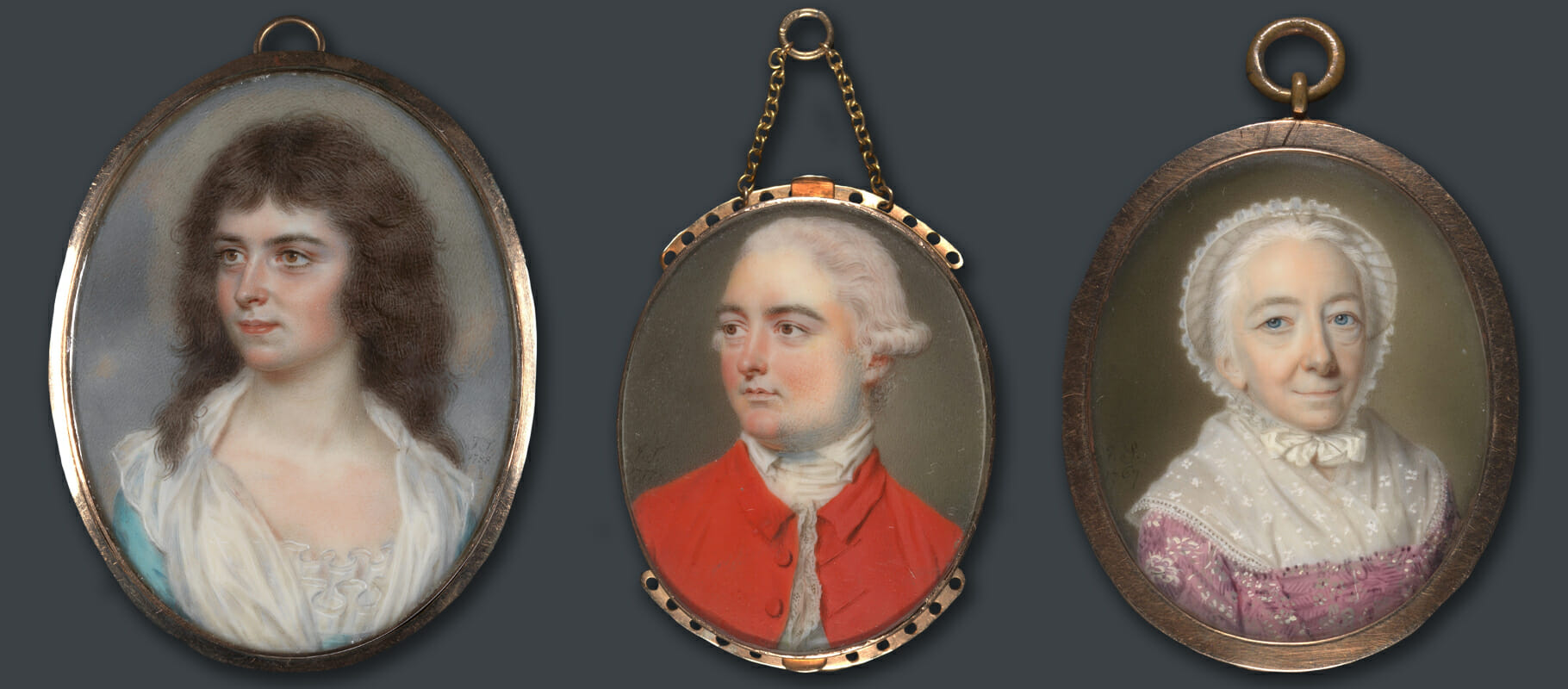 Above: a selection of 18th century miniatures by John Smart
Above: a selection of 18th century miniatures by John Smart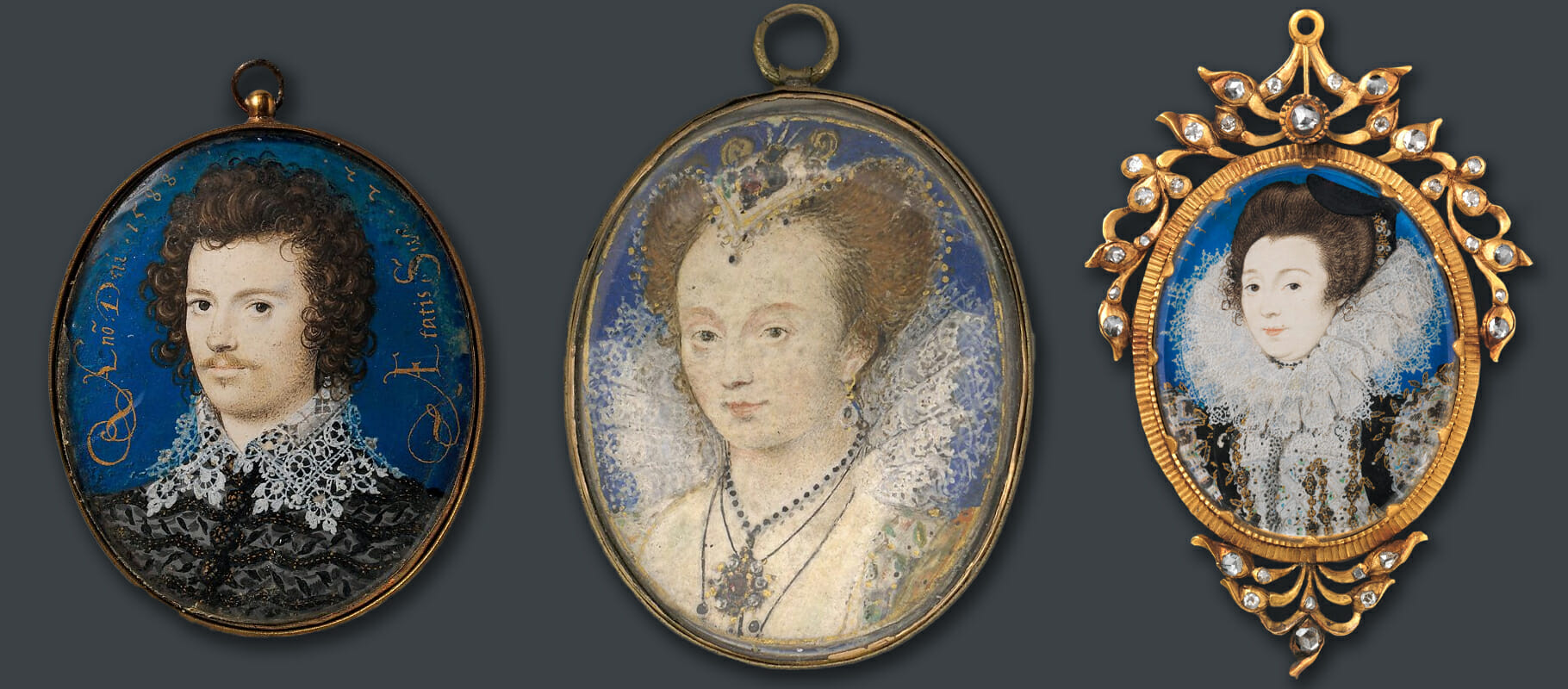 Above: a selection of 16th century miniatures by Nicholas Hilliard
Above: a selection of 16th century miniatures by Nicholas Hilliard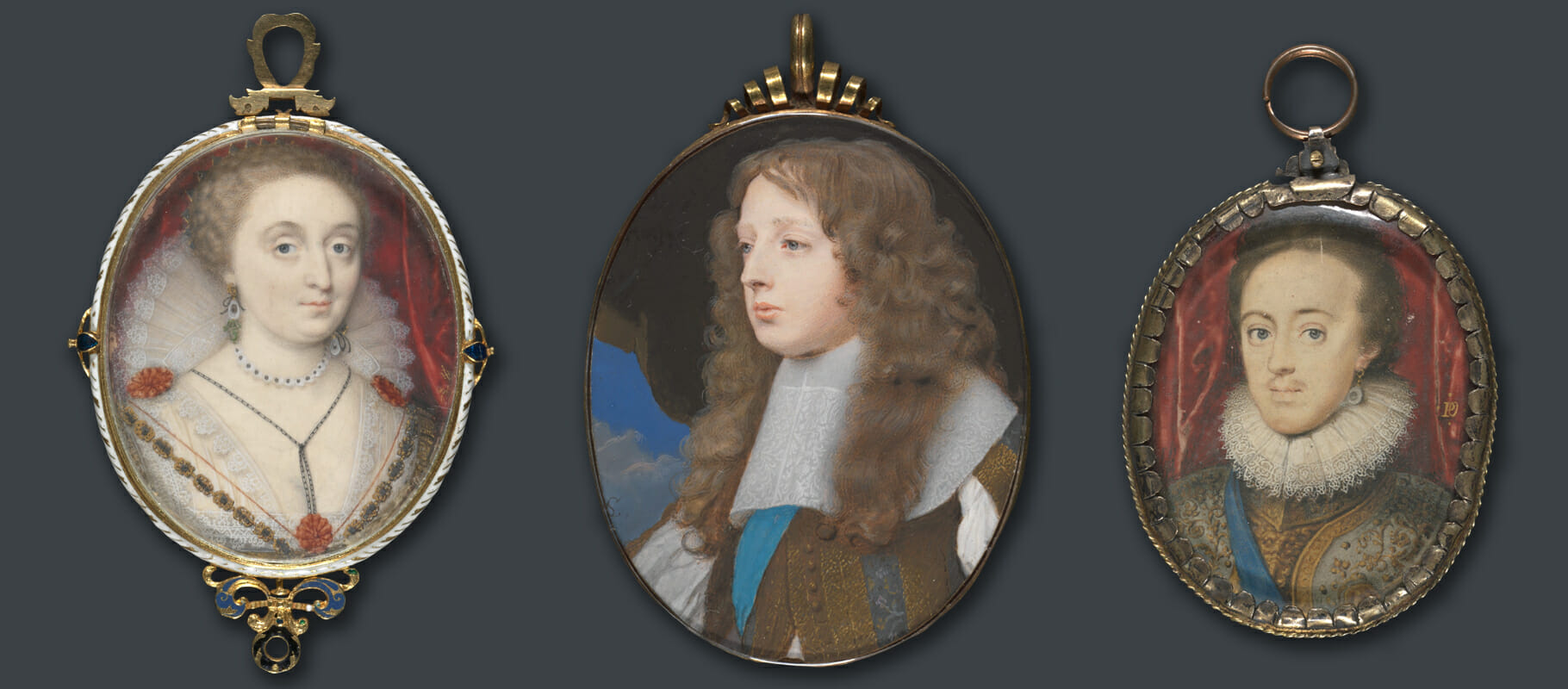 Above: a selection of 17th century miniatures by John Hoskins, Samuel Cooper and Peter Oliver
Above: a selection of 17th century miniatures by John Hoskins, Samuel Cooper and Peter Oliver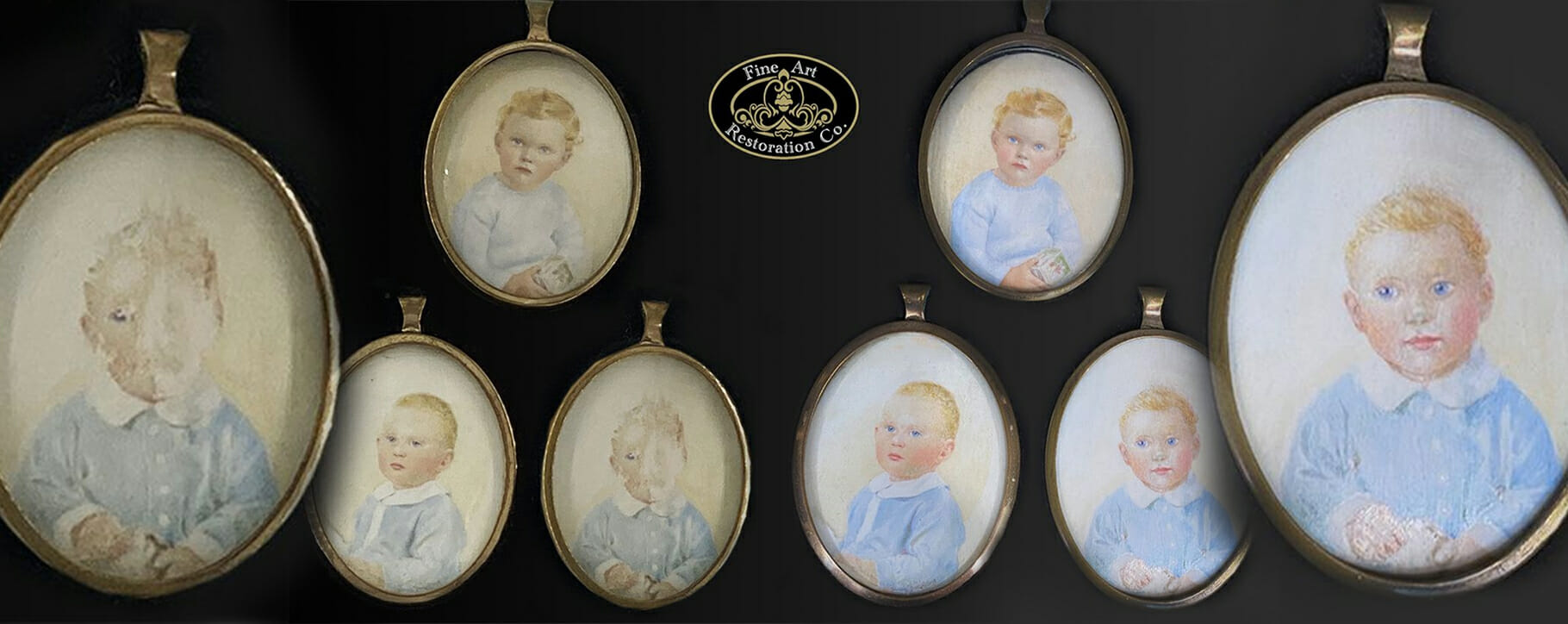 Above: a miniature portrait on paper that was accidentally rubbed away, before and after restoration using historic photographs of the sitter
Above: a miniature portrait on paper that was accidentally rubbed away, before and after restoration using historic photographs of the sitter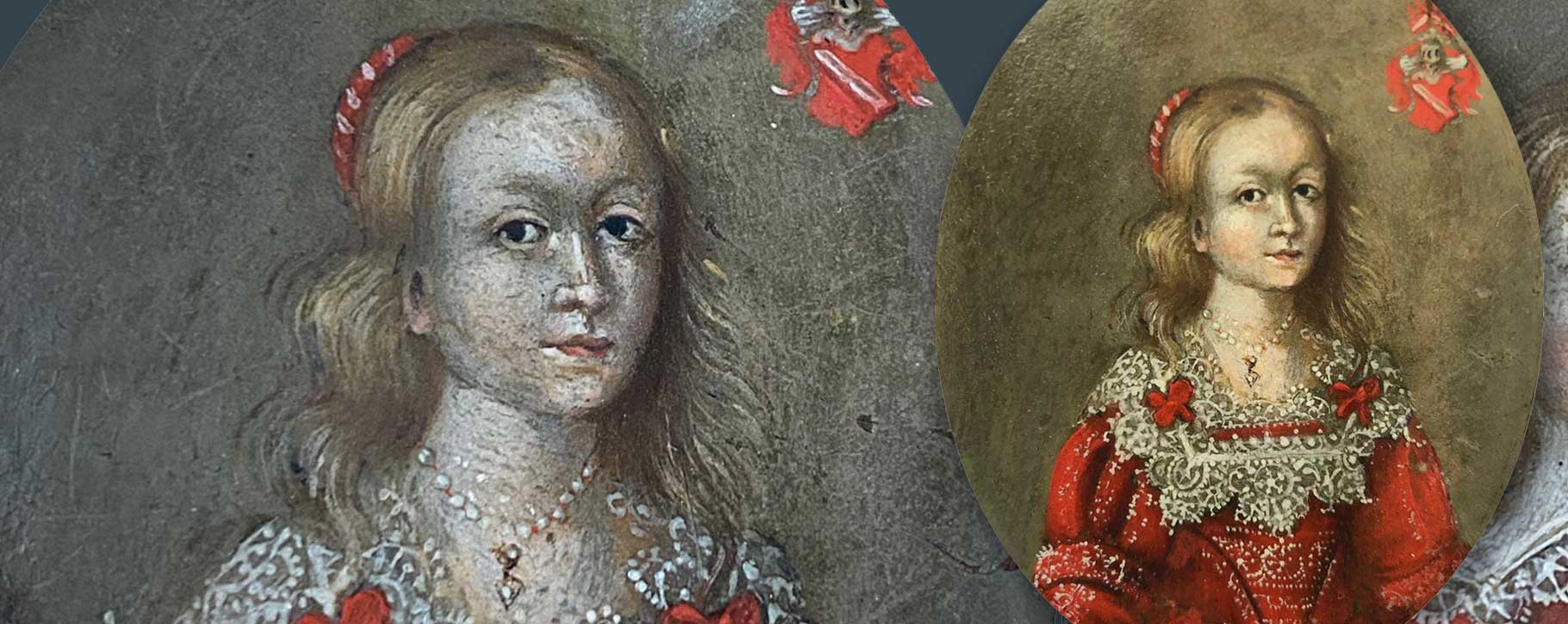 Above: a miniature on copper before and after conservation treatments in our studio
Above: a miniature on copper before and after conservation treatments in our studio




